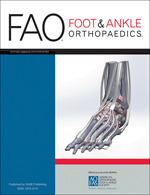
Does FHL Tendon Transfer Alter the Outcome of Haglund Deformity Treatment in Patients Older Than 50

Does FHL Tendon Transfer Alter the Outcome of Haglund Deformity Treatment in Patients Older Than 50
Does FHL Tendon Transfer Alter the Outcome of Haglund Deformity Treatment by Using Debridement and Ostectomy in Patients Older Than 50 Years? A Single-Blinded Randomized Controlled Trial.
Foot Ankle Orthop. 2024 Jul 24;9(3):24730114241262783.Synopsis
Forty patients older than 50 years with chronic Achilles tendinopathy following Haglund deformity, who did not respond to conservative treatment, were randomized to receive either debridement and ostectomy alone (control group, n=20) or debridement and ostectomy with flexor hallucis longus (FHL) tendon transfer (FHL group, n=20). The primary outcome of interest was improvement in American Orthopae...
To view the full content, login to your account,
or start your 30-day FREE Trial today.
FREE TRIAL
LOGIN
Forgot Password?
Explore some of our unlocked ACE Reports below!

Learn about our AI Driven
High Impact Search Feature
Our AI driven High Impact metric calculates the impact an article will have by considering both the publishing journal and the content of the article itself. Built using the latest advances in natural language processing, OE High Impact predicts an article’s future number of citations better than impact factor alone.
Continue



 LOGIN
LOGIN

Join the Conversation
Please Login or Join to leave comments.